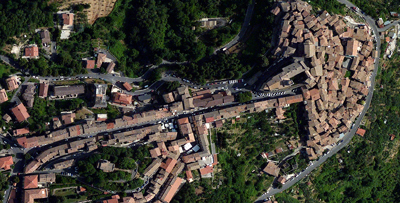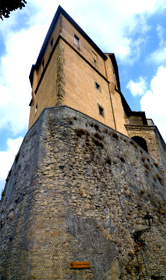You are in: Home page > Magazine Archive > Territorial organism and urban knottingt

Giuseppe Strappa
Territorial organism and urban knottingt
Design methods for minor centers of Lazio

Aerial photo of the historical centre of San Vito.
The research, currently being finalized by the study group by me coordinated at the Faculty of Architecture of "Sapienza" in Rome, within the more general topic of "City in extension", investigates the problem of how minor historical centers may experience contemporary transformations "congruent" with their formative process, in the belief that it is necessary to accept the incontrovertible fact that an urban organism, like any living organism, can only host continuous modifications.
The study is part of a general framework of the national research and shares the assumption that the connotations of the Italian landscape suggests alternative tools, compared to the current ones, for the architectural design, and the possibility of an original placement, with specific characters, in the international state art of the discipline.
In particular, the research examines the landscape characters of the Lazio region due to the diffusion in the territory of towns of considerable historical interest that are rapidly losing their quality.
These centers are structurally weakened also by the influence of the near metropolitan area of Rome, wich its rapidly changing its shape through a gradual disorganization.
The research proposes (and verifies the potential in some case studies), the reading of the urban fabrics of small towns, their form with typical characters, their potential “knotting”, the transformations in nodal places to form new nodal organisms, specialized building that innovate the existing fabric in a coherent and proportionate manner, allowing to avoid a “specialistic sprawl” (see the case of the displacement of the town halls outside of the town center) that is added, with a disastrous result, to the current residential sprawl.
It is necessary to find a new development model for many Italian historical "minor" towns which, under opposing pressures due to a new social and ethnic composition of the population (in many respects, however, a positive one) and the state of poor condition of many structures, are undergoing, in the last decades, an uncontrolled transformation.
In this context particularly relevant is the issue of the revitalization of minor historical centers of the Lazio region, which are architecturally and environmentally very valuable and are demanding new forms of protection. They do not require, in fact, only preventive measures to prevent the loss of valuable parts of a unique heritage, but are in need of a plan for "oriented" transformations.
The research, currently being finalized by the study group of the Faculty of Architecture at "Sapienza" in Rome, investigates, within the more general topic of "City in extension", on the subject of how these smaller towns may undergo over time transformations "congruent" with their formative process, with the belief that it is necessary to accept the unquestionable fact that an urban organism, like each living organism, is undergoing a continuous change.
It is not, in fact, only a legacy of the past to be preserved as a museum: these towns are, above all, a vital urban model and an example of settlement forms of great interest in urban planning and architectural literature.
They are living organisms whose value lies in the aptitude of their parts to work together for the life and the form of the settlement; organisms which must be respected and protected in their identity (their architectural, but also cultural and civic features) against the political trend to consider the problem as a purely technical-economic one.
They should be given, for this reason, a protection not only constituted by restraints and laws, but, in fact, an "active protection", understanding that every organism to survive, needs to be transformed over time, to adapt to the changing environmental conditions, maintaining however, the deep nature of its structure.
We believe that on the issue of the modernization of historical centers, a lot of misunderstandings have been done. The problem is not to imitate, fearing the provincialism, some European cities where spectacular buildings are introduced without congruence with the historical context (the real delay of Italian architecture is, in fact, the very same fear to be provincial). Our town centers are to be considered, on the contrary, in their essence of an "ongoing process ", a place for historically consistent transformations. And the contemporary project should be the continuation (not imitation) of the inherited characters.
Characters that still bind urban spaces and residential units in a choral collaboration expressed by shared facades: they are the modern essence of the ancient settlements, their structure is powerful and profound and should be understood and followed.
The research came to the conclusion that, against the widespread tendency of the plans for minor historical centers, used mainly for residential features, to place service facilities outside the historically built perimeter, it is necessary instead to give them a nodal function in the context of the area, transforming and specializing the fabric, as it happened with continuity in the evolution of Italian cities, even modern, through architectural and urban "knottings".
If one look at the simple evidence of the constructed reality, one cannot but observe, in fact, that, by the contradictory transition from traditional to contemporary Italian cities, there emerges a clear, traumatic innovation in the urban fabrics, but also an equally clear continuity in built organisms.
Some aspects of the substantial diachronicity between living organisms and the urban fabric have long been observed in the persistence of the process that generated the current “in linea” house starting from the recasting of former row houses. And yet it has never been held in account that the complex formative continuity, generated by the notion of aggregate, is present also in many specialized modern buildings. These buildings show their formative laws, "knotting" (turning into spatial nodes) places originally physically or virtually open: in the same manner as many built structures of the past, they arise from the dialectics between enclosure and roofing, between serial and organic structures, between city and building.
This phenomenon is detectable, especially in the dialectic between urban and interior spaces, in the new buildings created in the late nineteenth century and early twentieth century, when the transition from the courtyard to the nodal space manifests itself, in all its evidence, in the reuse of existing buildings on internal continuous paths organized around open spaces. It is not simply a technical reuse, but a cultural process where the mutation of the open space creates entirely new, more organic buildings. It's a process similar to that generating the Italian palazzo as the recast and organic solidarity of row houses forming an open space around which the buliding is knotted unfolding the life of the new building. This is transformed, in modernity, in a spatial and distributive node often forming a large central room, "logically" posterior to the first fusion between building units, as progressive cohesion of the built organism core with the urban space (born from the city, the spatial node goes back to life of the streets).
This process, heralded by many symptoms, falls in the fertile period of transition from the late '20s to early '30s, through rapid and complex mutations, ordered in logical sequences rather than chronological, traceable behind the plot of many facades "academically "modern.
Buildings that indicate, in an exemplary way, as the interpretation of many specialized buildings of the first half of the last century as an exclusive effect of new instances, belongs to the many mythologies of modernity. At its highest point, on the contrary, the story of the formation of many specialized buildings (see the exemplary case of the Italian postal palaces) seems to have been on the verge of achieving the aspiration for a synthesis of building and urban organism pursued by generations of architects.
The research therefore proposes, and verifies their potentialities in some case studies, the reading of the urban fabrics of smaller towns, their form with typical characteristics, potential transformations and knotting in nodal sites of the city to produce also new specialized architectures, that innovate the existing building in a congruent and proportional manner, so to avoid the specialized sprawl (see the case of the widespread displacement of the city halls outside of the center) that is added, with disastrous effects, to the residential sprawl.
In this general picture of the formation of a new role of minor historical, in our opinion, new contemporay instances should be considered, such as energy conservation and sustainability, as well as other issues, including the accessibility to facilities, all to be organically integrated into the "updating" process of historic fabrics.
The research is based on the belief that these potential changes, which should constitute the essence of contemporary design, present in different small towns of Lazio, within certain limits, common perspectives and characters, that allow the identification of an intervention method, that in some fundamental aspects is generalizable.
Bibliography
Strappa G., (1989). Tradizione e innovazione nell'architettura di Roma capitale, 1870 - 1930. Roma: Kappa.
Strappa G., (1990). Tracce nelle città, Roma.
Strappa G., (1995). Unità dell'organismo architettonico. Note sulla formazione e trasformazione dei caratteri degli edifici, Bari.
Strappa G., Mercurio, G. (1996). Architettura moderna a Roma e nel Lazio, Atlante. Roma: Edilstampa.
Strappa G., (1996). Nodi nelle città, in «Area» n°27.
Strappa G., (1996). La grande tradizione moderna dei Palazzi Postali, saggio introduttivo a AA.VV. I Palazzi delle Poste, Milano.
Strappa G., (1998). Caratteri specifici dell’architettura romana tra le due guerre, in: AA.VV. Roma 1918-1943, Roma.
Strappa G., (1998). The notion of enclosure in the formation of Special Building Type, in Typological Process and Design Theory, Cambridge.
Strappa G., Ieva M., Di Matteo M.A., (2003). La città come organismo. Lettura di Trani alle diverse scale, Bari.
D'Amato C., Strappa G., (a cura di) Gianfranco Caniggia. Dalla lettura di Como all'interpretazione tipologica della città, Bari 2003.
Strappa G., Menghini A.B. (a cura di), (2003). Architettura moderna mediterranea, in Atti del Convegno Internazionale, Bari, 10 aprile 2002, Quaderni ICAR/4, Dipartimento di Scienze dell'Ingegneria Civile e dell'Architettura Politecnico di Bari, Mario Adda Editore.
Strappa G., (2003). The City as Organism, in: A.Petruccioli, M.Stella, G.Strappa (a cura di), The planned city?, ISUF International Conference, Bari.
Strappa G., (2003). La nozione caniggiana di organismo e l'eredità della scuola di architettura di Roma, in Gianfranco Caniggia architetto (a cura di G.L.Maffei), Firenze.
Strappa G., (2004). Architettura moderna mediterranea in Italia, in AA.VV., Arte e cultura del Mediterraneo nel XX secolo, UNESCO, Roma.
Strappa G., (a cura di) (2005). Edilizia per il culto – Chiese, moschee, sinagoghe, strutture cimiteriali, Torino: UTET.
Strappa G., (2006). Organicità futura, in: Città di Pietra, catalogo della Decima Mostra di architettura alla Biennale di Venezia, Venezia.
Strappa G., (2006). Ridisegnare Ostia, in AA.VV., La riqualificazione del Lungomare di Roma, catalogo del Concorso internazionale, Roma.
Strappa G., (2006). Lettura e progetto dell’organismo urbano di La Valletta, Bari: Politecnico di Bari.
Strappa G., (2010). Rileggere lo Zen, in «Paesaggio urbano» n°5.
Cataldi G., Maffei G.L., Maretto M., Marzot N., Strappa G., (2011) cura dell’edizione italiana di: L’analisi della forma urbana. Alnwick, Northumberland, Milano.
Strappa,G. (a cura di) (2012). Studi sulla periferia est di Roma. Milano: Franco Angeli.
Giuseppe Strappa is Professor of Architectural and Urban Design at the Faculty of Architecture at the "Sapienza" of Rome, where he is director of the laboratory Lpa (Reading and Design of Architecture), coordinator of the PhD in Architecture and Construction as well as responsible for numerous scientific and educational programs.

Orsini Castle at San Vito.













